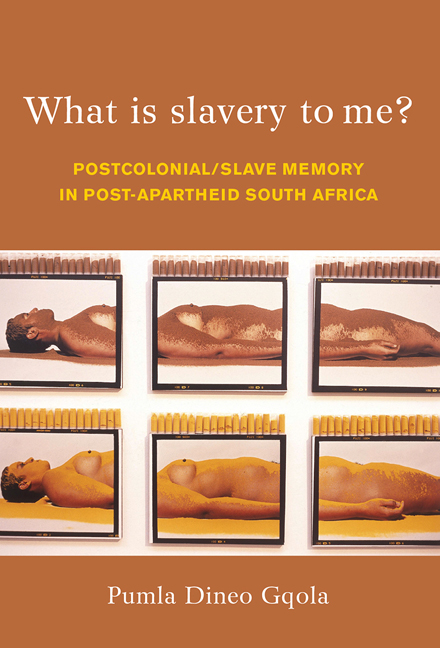Book contents
- Frontmatter
- Contents
- Dedication
- Acknowledgements
- Acronyms
- Introduction: Tracing (re)memory, thinking through echoes of colonial slavery in contemporary South Africa
- 1 Remembering differently: repositioned coloured identities in a democracy
- 2 (Not) Representing Sarah Bartmann
- 3 Whiteness remixed, or remembered impurity, shame and television
- 4 ‘As a slave you have to have faith or you'll give up’: Cape Malay/Muslim identity clusters in Cape Town
- 5 ‘Is the secret in cooking?’ Coded food, spice routes and processing Malay identities
- Conclusion: Unshackling memory, rememorying agency
- Endnotes
- References
- Index
Conclusion: Unshackling memory, rememorying agency
Published online by Cambridge University Press: 21 April 2018
- Frontmatter
- Contents
- Dedication
- Acknowledgements
- Acronyms
- Introduction: Tracing (re)memory, thinking through echoes of colonial slavery in contemporary South Africa
- 1 Remembering differently: repositioned coloured identities in a democracy
- 2 (Not) Representing Sarah Bartmann
- 3 Whiteness remixed, or remembered impurity, shame and television
- 4 ‘As a slave you have to have faith or you'll give up’: Cape Malay/Muslim identity clusters in Cape Town
- 5 ‘Is the secret in cooking?’ Coded food, spice routes and processing Malay identities
- Conclusion: Unshackling memory, rememorying agency
- Endnotes
- References
- Index
Summary
Studies in post-apartheid memory abound, but these are usually limited to the study of colonial and/or apartheid memory. This book makes an intervention by reading slave memory post-apartheid, recognising that ‘sites of cultural displacement and encounter may thus be seen to offer, albeit chaotic and unguaranteed, revised definitions of the self within a wider political, geographical and cultural dimension’ (Thomas 2000: 12). In order to do so, I have explicitly chosen a postcolonial feminist location because it privileges subaltern compositions and valuation of meanings, rather than an outward-looking explanatory framework.
My chosen critical vocabulary, methodological stance and theoretical tools are well suited to uncovering the new ways in which slave memory functions in unpredictable, sometimes contradictory ways for different groups in contemporary South Africa. This multiplicity and conceptual untidiness has been read through frameworks that highlight movement, such as the echo chamber and helix-like postcolonial memory. My explicit discussions of Morrison's rememory, Pennington's helix-shaped memory and Williams's memory as a shadow – all three my key theoretical models – directly address the refusal (or failure) of memory to be flattened or made linear/truth. For example, the claims to an indigenous Khoi ancestry have worked to inconsistent ends for both Khoisan and white societies, as shown in Chapters 1 and 3. This shows that claims to historically indigenous identities are made for reasons that are not always progressive (Strauss 2009).
The paucity of written material by enslaved people dating from this era, as well as the short trajectory of the historiography focusing on slavocratic South Africa, mean that explorations of slave pasts need to be self-consciously excavatory. Perhaps this is why the archaeological dig has been so popular as a means of opening up this debate. Historians of slavery, such as Susan Newton-King, Patricia van der Spuy, Robert Shell, Wayne Dooling, Pamela Scully, Robert Ross, and Nigel Worden have done enormous work in this regard in a very short space of time. Nonetheless, that very few specific names come to mind in relation to this topic also points to the novelty of the subject within the South African context.
- Type
- Chapter
- Information
- What is Slavery to Me?Postcolonial/Slave Memory In Post-Apartheid South Africa, pp. 201 - 213Publisher: Wits University PressPrint publication year: 2010



